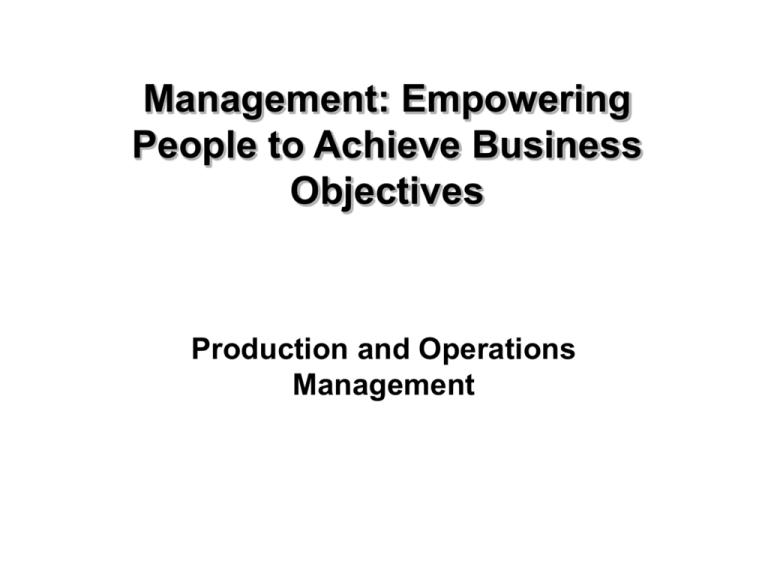
Management: Empowering
People to Achieve Business
Objectives
Production and Operations
Management
11-1
Copyright © 2005 by South-Western, a division of Thomson Learning, Inc. All rights reserved.
Overview
• Businesses can create or enhance four basic
kinds of utility: time, place, ownership, and
form
• Businesses are compensated for creating or
enhancing utility
• “Value added” – important concept
11-2
Copyright © 2005 by South-Western, a division of Thomson Learning, Inc. All rights reserved.
The Production Process: Converting Inputs
to Outputs
11-3
Copyright © 2005 by South-Western, a division of Thomson Learning, Inc. All rights reserved.
Strategic Importance of the
Production Function
• Mass Production—system for manufacturing products in
large amounts through effective combinations of employees
with specialized skills, mechanization, and standardization
• Assembly Line—manufacturing technique that carries
the product on a conveyor system past several
workstations where workers perform specialized tasks.
• Henry Ford
• Can have car in any color as long as it is black.
• Used seat crates as floor boards
11-4
Copyright © 2005 by South-Western, a division of Thomson Learning, Inc. All rights reserved.
Strategic Importance of the
Production Function
• Flexible production—producing small batches of
similar items
• e.g. Print-on-demand
• Customer-driven production—evaluates customer
demands in order to link what a manufacture makes
with what the customers want to buy
• e.g. Dell
11-5
Copyright © 2005 by South-Western, a division of Thomson Learning, Inc. All rights reserved.
Production Processes
• Means of operating
• analytic system
• e.g. refineries
• synthetic system
• e.g. auto manufacturer
• Time requirements
• continuous process
• just keep doing the same thing, all the time
• e.g. steel industry, refineries, power plants
• intermittent process
• most services because each job is unique
• e.g. tax preparation, plumbers, dentists
11-6
Copyright © 2005 by South-Western, a division of Thomson Learning, Inc. All rights reserved.
Technology and the Production Process
• Computer-Aided Design (CAD)
• Computer-aided manufacturing (CAM)
• Robots
• 3D printing
• Surfboard example
11-7
Copyright © 2005 by South-Western, a division of Thomson Learning, Inc. All rights reserved.
Factors in the Location Decision
11-8
Copyright © 2005 by South-Western, a division of Thomson Learning, Inc. All rights reserved.
The Job of Production Managers
• Determining the Facility Layout
• Determining the best layout for the facility
requires managers to consider all phases
of production and the necessary inputs at
each step
• Process Layout
• Product Layout
• Fixed-Position Layout
• Customer-Oriented Layout
11-9
Copyright © 2005 by South-Western, a division of Thomson Learning, Inc. All rights reserved.
Process Layout and Product Layout
11-10
Copyright © 2005 by South-Western, a division of Thomson Learning, Inc. All rights reserved.
Fixed-Position Layout
11-11
Copyright © 2005 by South-Western, a division of Thomson Learning, Inc. All rights reserved.
Customer-Oriented Layout
11-12
Copyright © 2005 by South-Western, a division of Thomson Learning, Inc. All rights reserved.
The Job of Production Managers
• Inventory Control
• Requires balancing the need to keep
stocks on hand to meet demand against
the expenses of carrying the inventory
• Perpetual inventory: system that
continuously monitors the amounts and
location of inventory
• Vendor-managed inventory: system
that hands over a firm’s inventory control
functions to suppliers
11-13
Copyright © 2005 by South-Western, a division of Thomson Learning, Inc. All rights reserved.
Implementing the Production Plan
• Just-in-Time System (JIT) —
management philosophy aimed at
improving profits and return on investment
by minimizing costs and eliminating waste
through cutting inventory on hand.
11-14
Copyright © 2005 by South-Western, a division of Thomson Learning, Inc. All rights reserved.
Controlling the Production Process
Scheduling—development of timetables that specify
how long each operation in the production process
takes and when workers should perform it.
Gantt chart—tracks projected and actual work
progress over time
PERT (Program Evaluation and Review
Technique)—chart which seeks to minimize delays
by coordinating all aspects of the production process
Critical Path—sequence of operations that
requires the longest time for completion
11-15
Copyright © 2005 by South-Western, a division of Thomson Learning, Inc. All rights reserved.
Sample Gantt Chart
11-16
Copyright © 2005 by South-Western, a division of Thomson Learning, Inc. All rights reserved.
PERT Diagram for Building a Home
11-17
Copyright © 2005 by South-Western, a division of Thomson Learning, Inc. All rights reserved.
Benchmarking
• Continually comparing and measuring
performance against outstanding performers.
11-18
Copyright © 2005 by South-Western, a division of Thomson Learning, Inc. All rights reserved.







